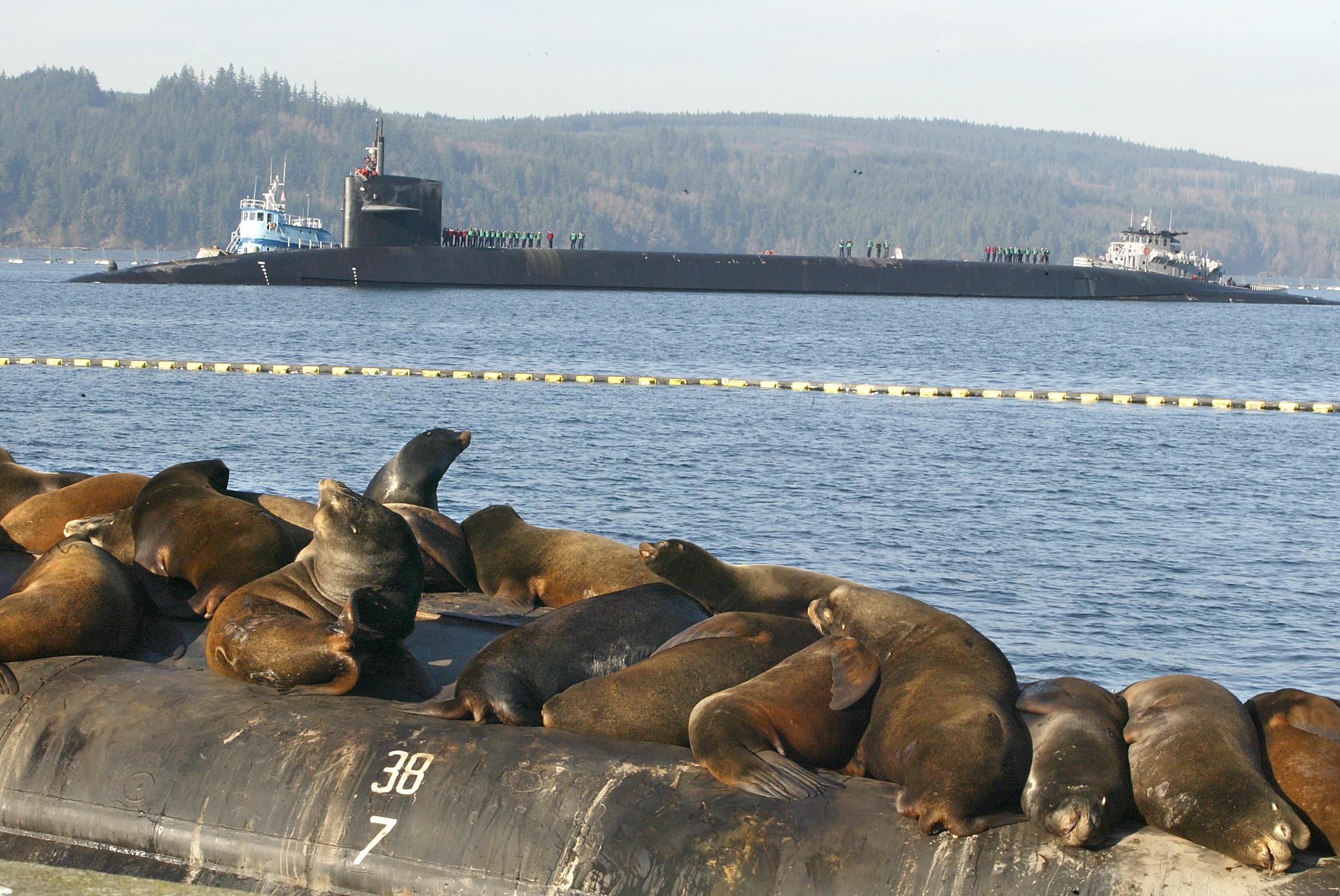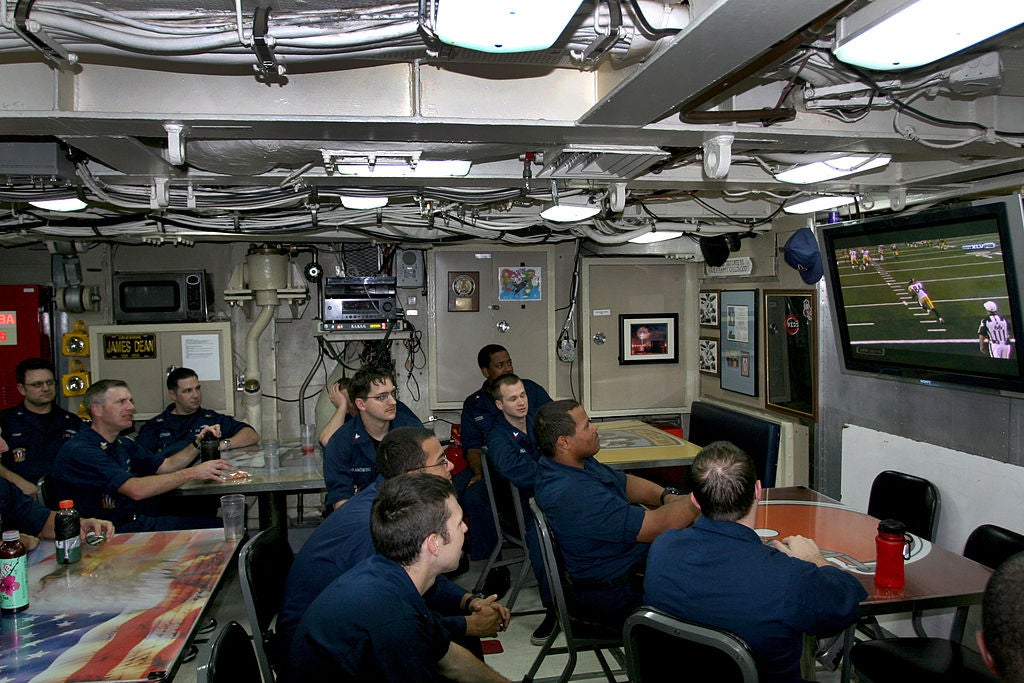HOME
ADDITIONAL INFO
With plenty of photos
Image source is the Submarine Group
Nine Facebook page unless stated otherwise.
For the unlikely event that the Ohio class submarine becomes disabled on the ocean floor and didn't implode from excessive water pressure, there are white markings on their hatches to aid rescue subs to dock with the disabled sub.
Looks like someone doesn't know how to correctly lock wire a pair of fasteners.
IMAGE SOURCE: Flickr
Deactivated missiles on display showing
off their massiveness. The Trident D5 is the larger
one and it's neighbors are the older Polaris and Trident
C4 missiles. This is partly why submarines have only
gotten bigger since their inception.
 In the post-Cold
War era, a few of the Ohio class have been converted from
their status as a nuclear deterrent to a more conventional
role of a cruise missile platform. Modifications
include 22 missile tubes to hold a total of 154 smaller
Tomahawk missiles and the remaining 2 tubes serving as
lock-out chambers for the submersibles shown in the second
image. These modifications allow for a distinct
advantage over fast attack submarines when utilized in
current war zones since they carry many more Tomahawks and
also have the space to support over twice as many Navy
SEALs (60+). Doing all of this changes their hull
designation to SSGN.
In the post-Cold
War era, a few of the Ohio class have been converted from
their status as a nuclear deterrent to a more conventional
role of a cruise missile platform. Modifications
include 22 missile tubes to hold a total of 154 smaller
Tomahawk missiles and the remaining 2 tubes serving as
lock-out chambers for the submersibles shown in the second
image. These modifications allow for a distinct
advantage over fast attack submarines when utilized in
current war zones since they carry many more Tomahawks and
also have the space to support over twice as many Navy
SEALs (60+). Doing all of this changes their hull
designation to SSGN.IMAGE SOURCE: Wikimedia
The water is very good at hiding the
true size of these submarines.

IMAGE SOURCE: Reddit
It is common for a submarine to run it's
diesel generator on it's last few hours before returning
to port as evidenced by the white plume of exhaust coming
from this one's sail. Along side the ship are the
usual Coast Guard escort boats. The protection of
nuclear technology is so important that these escorts are
carrying very dense containers on deck to act as a shield
from explosive projectiles. This is in addition to
the fact that they are also very heavily armed.

Even when shutdown in port, the reactor systems are usually kept in a relatively hot condition to facilitate a faster startup. There are material concerns associated with heat up that normally make a cold start up very slow. The side effect is that the engine room is always warm enough to encourage sea lions to use the hull as a beach.
IMAGE SOURCE: The Spokesman-Review
One of only a few watertight doors,
which are the only way to move from one compartment to
another. In addition to preventing the spread of
flooding into other compartments, they also serve as
containment boundaries in the event of a reactor accident,
fire, steam, etc.
IMAGE SOURCE: Amy
Eckert

IMAGE SOURCE: Amy
Eckert
IMAGE SOURCE: navsource.org
If you're really low in the hierarchy, your sleeping arrangements are like the left setup, always at risk of being woken when supply needs to get into the parts cabinets on either side of you. Most people, however, get the setup on the right: a bunk room that sleeps 9 crew members with personal storage space being nothing more than the space under the bed. The good news, in any case, is that no one has to share beds like they do on the smaller fast attack submarines.
If you're really low in the hierarchy, your sleeping arrangements are like the left setup, always at risk of being woken when supply needs to get into the parts cabinets on either side of you. Most people, however, get the setup on the right: a bunk room that sleeps 9 crew members with personal storage space being nothing more than the space under the bed. The good news, in any case, is that no one has to share beds like they do on the smaller fast attack submarines.
Once you get inside of one, it really
isn't that bad. Soundproof walls, adjustable A/C
vent, and a breathing mask. What more can you ask
for?
IMAGE SOURCE: This was literally my
bunk.


Internal communication becomes one of
the most important factors during an emergency.
Because of this, the communication circuits are not
powered by the electrical system at all. Instead,
the telephones are sound-powered. The receiver
converts the kinetic energy of sound waves into
electricity like any other phone, but this signal alone is
what converts back into sound on the other end's
speaker. There is no external electrical source to
amplify the signal.
IMAGE SOURCE: Atomic Photographers Guild
IMAGE SOURCE: Atomic Photographers Guild

Sonar isn't just a single person
listening to the environment through headphones, it's an
entire team and headphones playing only a partial
role. The Ohio class has many hydrophones and other
detection equipment all over the ship. Monitoring
the ship's own noise is also part of the job. To
organize all this data, the signals get automatically
translated into a visual representation on screens.
IMAGE SOURCE: Wikimedia
IMAGE SOURCE: Wikimedia
Everything that vibrates is resiliently
mounted with shock absorbers. From something as
small as 1/4" high pressure air pipe to the entire
propulsion train free floating on giant rubber
mounts. Sound silencing is probably the reason why
submarines frequently need to deliberately be as loud as
possible in order to give surface ships a fighting chance
during war games.
IMAGE SOURCE: National Geographic, Youtube
IMAGE SOURCE: National Geographic, Youtube
IMAGE SOURCE: National
Geographic, Youtube
IMAGE SOURCE: Amy
Eckert
The torpedo room is the largest room in
forward compartment. Not only does it store 8
torpedoes on either side of the ship for easy loading into
one of the 4 torpedo tubes, but even more are stored on
the room's center platform (shown here behind the men as
empty). Gone are the days of using block and tackle
systems to move them around. Instead, everything is
equipped with hydraulics, including the floor so that it
can be raised to the level of the center platform and the
torpedoes can simply slide on rails to the outer edges.
Author: David Atwood | Physics 212 | 02 January 2019 | Design: HTML5 UP

 IMAGE SOURCE:
IMAGE SOURCE: 